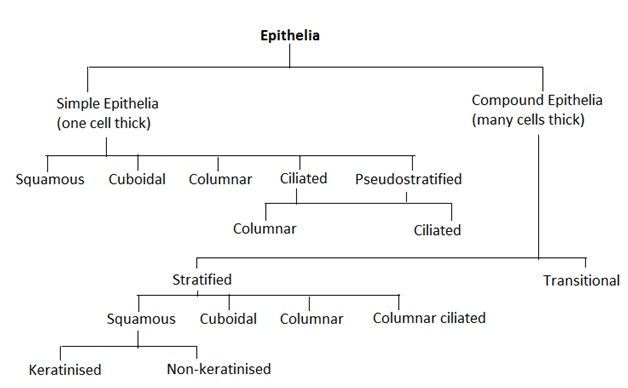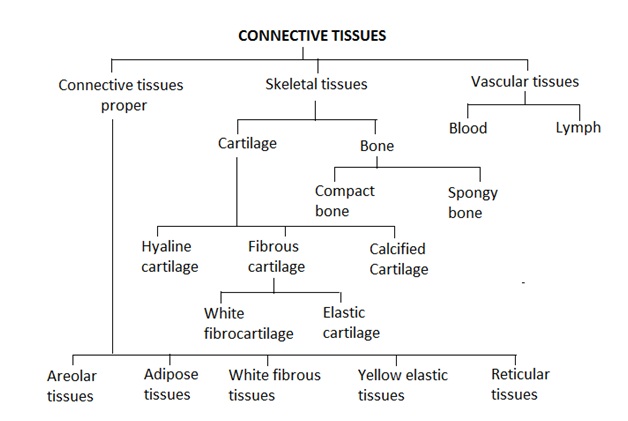Structural Organisation in Animals
Table of Content |
 Body of an animal is formed of several kinds of cells. There are about 200 different types of specialized cells in the human body. The cells of one or more kinds are arranged together in a characteristic manner and cooperate to perform a specific role. Such a group of cells is called a tissue. The cell of a tissue may secrete between them a nonliving intercellular material. Thus, a tissue may be defined as a group of one or more types of cells having a similar origin and specialized for a specific function or functions along with the intercellular material.
Body of an animal is formed of several kinds of cells. There are about 200 different types of specialized cells in the human body. The cells of one or more kinds are arranged together in a characteristic manner and cooperate to perform a specific role. Such a group of cells is called a tissue. The cell of a tissue may secrete between them a nonliving intercellular material. Thus, a tissue may be defined as a group of one or more types of cells having a similar origin and specialized for a specific function or functions along with the intercellular material.
Branch of biology dealing with the study of tissue is called histology. The term ‘tissue’ was introduced by Bichat who is also known as the ‘Father of histology’. Mayer coined the term ‘histology’ and the founder of histology is Marcello Malpighi. Histological study of an organ called Microscopic Anatomy. Marcello Malpighi is the father of microscopic anatomy. Hertwig introduced the term ‘mesenchyme’ for mesodermal tissue. The formation of tissues from germinal layer is called as histogenesis.
Tissues
A group of one or more types of cells having a similar origin and specialized for a specific function or functions is called tissue.
The tissues are classified into four main groups on the basis their location and functions:-
1) Epithelial tissue
2) Connective tissue
3) Muscular tissue
4) Nervous tissue
Origin & Main Roles of Major Tissues:-
|
S. No. |
Name |
Origin |
Main Functions |
|
1. |
Epithelial Tissues |
Ectoderm, Mesoderm, Endoderm |
Protection, secretion, absorption, excretion, reproduction |
|
2. |
Muscular Tissues |
Movement of parts & locomotion |
|
|
3. |
Connective tissues |
Mesoderm |
Attachment, support, protection, storage, transport |
|
4. |
Nervous tissues |
Ectoderm |
Control and coordination by nerve impulse induction |
(A) Epithelial Tissue
An epithelium is a tissue composed of one or more layers of cells that cover the body surface and lines its various cavities. It serves for protection, secretion and excretion. The word ‘epithelium’ was introduced by Ruysch.

Classification of Epithelial Tissue:
(a) Simple epithelium: It is simple in structure and basically formed by single layer cells.
(1) Simple squamous epithelium: It is consists of only one layer of flat, scale like cells, usually polygonal cells which are closely fitted together like the tiles of a mosaic. It is also known as pavement epithelium.
(2) Simple cuboidal epithelium: The simple cuboidal epithelium is composed of one layer of cuboidal shaped cells resting on a basement membrane. The nuclei are situated centrally.
(3) Simple columnar epithelium: It consists of a single layer of cells, many of which have modified structure. Three common modifications are goblet, cilia and microvilli.
(4) Simple ciliated epithelium: It bears numerous delicate hair like outgrowths called cilia arising from basal granules help to create a current to transport the materials. 
(B) Muscle Tissues
Muscle tissue is a soft tissue which composes muscles in animal bodies. The cells of Muscle tissues are called myocytes.

(C) Connective Tissue
It connects and supports all the other tissues, the intercellular element predominating. The cellular element is usually scanty. In function this tissue may be mechanical, nutritive and defensive. It is a tissue made up of matrix (abundant intercellular substance or ground substance) and living cells that connects and support different tissues. Connective tissue was called mesenchyme by Hertwig (1893).
Skeletal Tissues
It provides support and surface for attachment of muscle. Skeletal connective tissues form the frame work of body. It provides rigidity to the body. These protect the various organ and help in locomotion. It is of three types.
(i) Cartilage: Cartilage is a solid but semi-rigid and flexible connective tissue. Cartilage is a nonvascular connective tissue, consisting of cells embedded in a resilient matrix of chondrin.
(ii) Bone: Bone is a highly calcified (mineralized), hard and rigid connective tissue. It is the major component of adult vertebrate endoskeleton. Besides its mechanical function of supporting the body architecture and internal organs as a frame work, of protecting delicate organ like brain, heart, etc. of forming to muscles to facilitate movement and locomotion
(D) Nervous Tissues: -
The cells of nervous tissues are specialized for receiving stimuli and transmitting messages.


-
Topics Covered:
| 1 | |
| 2 | |
| 3 | |
| 4 |
To read more, Buy study materials of Structural Organisation in Animals comprising study notes, revision notes, video lectures, previous year solved questions etc. Also browse for more study materials on Biology here.
View courses by askIITians


Design classes One-on-One in your own way with Top IITians/Medical Professionals
Click Here Know More

Complete Self Study Package designed by Industry Leading Experts
Click Here Know More

Live 1-1 coding classes to unleash the Creator in your Child
Click Here Know More

a Complete All-in-One Study package Fully Loaded inside a Tablet!
Click Here Know MoreAsk a Doubt
Get your questions answered by the expert for free